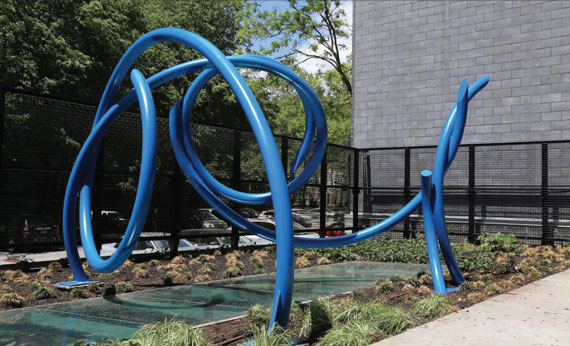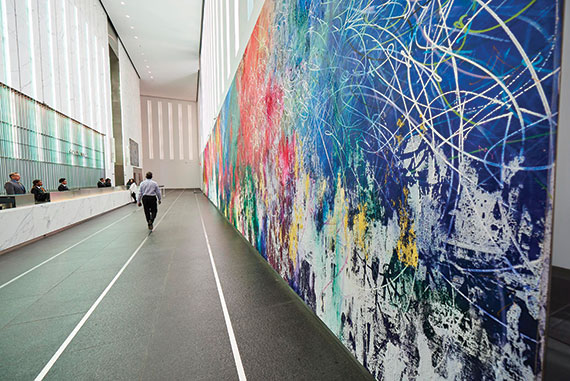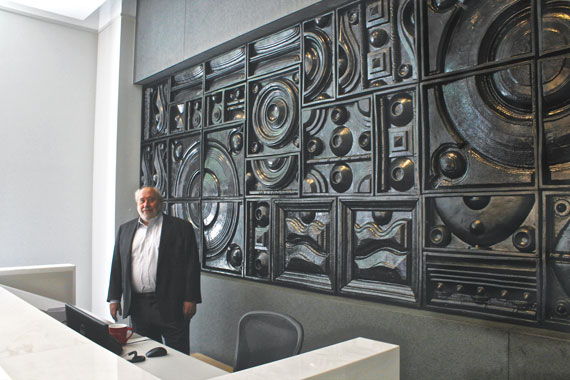Opening night at Fortis Property Group’s new condo project, 212 North 9th Street in Williamsburg, got an added boost from an unlikely source: A piece of abstract art. The building, which features a rooftop mural by contemporary artist David Paul Kay, done in his vibrant black-and-white style, was a big crowd pleaser.
And the mural was not just on exhibit, it’s painted on the roof — the most notable amenity in a building that also sports an art library, indoor parking and private outdoor space for almost every unit.
Brokers have long used loaned art to stage new development apartments, but these days developers are increasingly incorporating art into the public spaces of residential projects, much like commercial developers have done for decades. The move to “art-up” is being driven by several factors, from upping a building’s cultural cache to helping push up prices.
“A fabulously designed lobby by some well-known interior designer or artist is going to demand a higher rent,” said Adam Courtney, an associate director at commercial brokerage Lee & Associates, who holds a master’s degree in public art from the University of Southern California.
But it’s not just lobbies and rooftops getting new art installations.
At the Herzog & de Meuron-designed 56 Leonard Street in Tribeca, developers Alexico Group and Hines commissioned an outdoor piece by renowned artist Anish Kapoor similar to his famous “Cloud Gate,” a bean-shaped sculpture in Chicago’s Millennium Park. The sculpture, Kapoor’s only in New York, will be wedged under an outcropping on the building, and is likely to become a destination in itself for contemporary art lovers.
Installing art in residential projects, sources say, appeals to buyers who consider themselves “creative types,” as well as those who see art as a status symbol.
“People who put incredibly expensive paintings in their lobbies — hopefully they are demonstrating a love for art, but they are also demonstrating the wealth and power that that art stands for,” said Courtney.
Not breaking the bank
Art doesn’t need to be outrageously expensive to make a statement, according to Emily Santangelo, an art consultant who has curated works at developments like the Christian de Portzamparc-designed 400 Park Avenue South, a hybrid condo-rental by Toll Brothers City Living and Equity Residential.
Santangelo said she encourages developers to set aside 1 percent of their project’s budget for art, though she admitted that the amount is more than most are willing to spend.
Santangelo found a large sculpture by John Clement for above the skylight of Equity Residential’s luxury rental building at 170 Amsterdam Avenue, where she said she’s placed art totaling upwards of $250,000. She said that Clement, who is based in Long Island City, typically gets $80,000 to $200,000 for large pieces.

“Tidal,” a sculpture by artist John Clement at Equity Residential’s 170 Amsterdam Avenue.
Meanwhile, apartments in the 239-unit building rent for $3,400 (for a studio) to $17,000 per month (for a three-bedroom). By comparison, the current neighborhood average is $2,065 (for a studio) and $6,164 (for a three-bedroom), according to data from brokerage Citi Habitats.
“I’m going to give [developers] the best possible look for the space, and they don’t need to spend a million dollars,” Santangelo said.
Works by blue-chip artists are, of course, more expensive.
But when developers are purchasing the art to keep permanently rather than as an investment, they don’t need to go for that top tier, Santangelo said.
“There is this echelon that is bankable. But [developers] don’t need to do that. I have been beating this drum for a long time,” she said.
In fact, observers say that the most financially beneficial use of art for a developer is often to keep it in place and use it to help drive up sales or rental prices in the building.
Art in a building “drives a premium for those who appreciate it,” said Jonathan Kaufman Iger, CEO of Sage Realty Corp., William Kaufman Organization’s leasing and management division. But there’s no formula to determine exactly what the upcharge is.
Expanding on tradition
While placing artwork in residential projects is a more recent trend, commercial buildings have been adorned with paintings and sculptures from time immemorial.
From Edward Trumbull’s mural adorning the lobby ceiling of the Chrysler Building, installed in 1930, to Isamu Noguchi’s Red Cube at 140 Broadway dating from 1968, New York City’s office buildings feature a wide array of well-known artwork that’s been in place for decades.
And that’s continuing in newer buildings: The office portion of Tower 46 at 55 West 46th Street, which is owned by SL Green Realty, features British artist Sarah Morris’ 28-foot painting “2008 (Rings)” a 1960s-reminiscent Mod graphic inspired by the 2008 Summer Olympics and estimated to cost between $300,000 and $400,000.
In the Durst Organization’s One World Trade Center, an approximately $3.8 billion project, the developer spent roughly $1 million on artwork, including a 90-foot-long abstract mural by Brooklyn-based artist José Parlá, according to Adelaide Roset, an art consultant with Edelman Arts, who helped curate the space.

A 90-foot long abstract mural by artist José Parlá at One World Trade Center.
“They got bad reviews on the architecture, but all of the reviews on the art were great,” Roset said. “It’s gotten a lot of press. Now they get why it’s good to have art in your buildings.”
Of course, there are well-known artists and then there are really well-known artists.
When a piece by Jeff Koons, Roy Lichtenstein or Alexander Calder lands in the public space of a building, it’s a safe bet that the work is either part of the developer’s private collection (see related story on page 48), being leased, or on loan from a gallery.
Developer Edward Minskoff is well known in art circles for displaying Koons’ candy apple-colored “Balloon Rabbit (Red)” in the lobby of his office building 51 Astor Place, which houses, among other high-profile tenants, IBM. The sculpture, however, is part of his personal collection, and was not part of the development budget.
Minskoff declined to reveal how much he paid for it, but other large sculptures by the artist were auctioned for nearly $60 million in 2013, around the same time that Minskoff got his sculpture, seven and a half years after commissioning it.
Opened in 2013, the Fumihiko Maki-designed 51 Astor reportedly commands record rents for the East Village, exceeding $100 per foot. Minskoff said that while he sees great architecture as an important factor in commanding higher rents, artwork in a building is more like “a little cherry on top of the cake.”
The Koons rabbit was not part of his business plan: He originally planned to display the 14-foot-tall, 6,600–pound sculpture in the yard of his Southampton home, but decided that exposing it to the elements was too risky.
Décor for rent
Developers without extensive private collections of their own can obtain top-shelf art through leasing.
The practice offers a cheaper way to get recognizable art into a building. And while the art is not considered an asset, it does qualify for a tax write-off.

Developer Yitzchak Tessler in the sales gallery of 172 Madison with a piece of art that will soon be installed at the condo tower.
“Even though we are talking about multi-million-, and sometimes multi-billion-dollar buildings, they don’t always want to use that capital on art,” said Roset, who in addition to consulting for Edelman now also works for a new art leasing company called Artemus, co-founded by the Dursts, financier Asher Edelman, and private equity executive David Storper.
“By leasing, they preserve that capital. It is financially advantageous, especially on the tax write-off,” she added, noting that Artemus’ clients can lease an $8 million art portfolio for $50,000 a month, or a $2 million portfolio for $13,000
a month.
Getting a gallery to loan out a piece of art for free, however, is another option.
At the William Kaufman Organization, which has a permanent collection, there are also currently at least six pieces on display lent by galleries, including a Sterling Ruby painting at the firm’s 767 Third Avenue office building. Ruby’s works have sold at auction for above $1 million.
Some developers say their motivation for installing art is pure.
“I didn’t do it to add value,” developer Yitzchak Tessler said of a massive ceramic wall-hanging he plans to install in his Midtown condo tower at 172 Madison Avenue. “I did it because I think it’s beautiful and it’s special.”
And in most cases, buying that beauty is a drop in the bucket when it comes to New York City development prices.
The social cachet is harder to quantify than the value of actual art. And for developers, being branded as a patron of the arts is a coveted characterization.

Artist Tom Fruin’s “Watertower” on the rooftop at Two Trees’
20 Jay Street in Dumbo, a neighborhood where the firm has established itself as a patron of the arts.
For its part, Two Trees Management has successfully branded itself as a benefactor of the entire Dumbo arts community. Of course, boosting the desirability of the neighborhood only makes the company’s buildings there more of a commodity. Now the firm is including art at its yet-to-be-built Domino Sugar development site in Williamsburg, where the construction barricade has become a commissioned mural.
The firm has a full-time cultural affairs coordinator, Lisa Kim, who organizes these projects. And, according to a source, the company has a yearly budget exceeding seven figures dedicated to public arts.
At Domino, construction costs will be over $1 billion; so including art will be a small price to pay in exchange for the buzz the art will likely generate.
